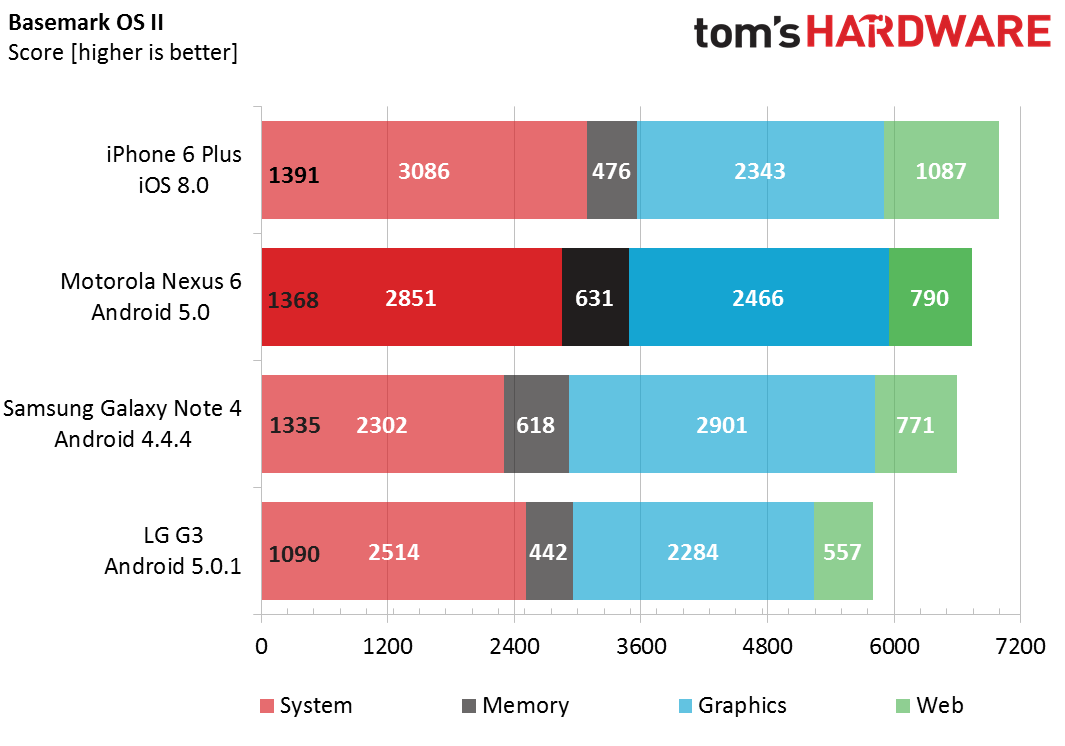Google Nexus 6 Review
Why you can trust Tom's Hardware
CPU And System Performance
In this section, we evaluate system-level performance by running a series of synthetic and real-world workloads, along with some browser-based Web tests. There are several facets to overall device performance, including single- and multi-threaded CPU performance, memory and storage speed, and GPU rendering, all of which will be probed by our suite of benchmarks. If you're interested in learning more about how these benchmarks work, what versions we use, or our testing methodology, please read our article about how we test mobile device system performance.
The Nexus 6 and Galaxy Note 4 both use Qualcomm's Snapdragon 805 SoC, with four Krait 450 CPU cores running at up to 2.65GHz. There's also an Adreno 420 GPU on-board paired with two 64-bit channels of LPDDR3-800 RAM for a total of 25.6 GB/s of throughput (the same peak bandwidth offered by the newer Snapdragon 810 and Exynos 7420 with LPDDR4 RAM). Based on hardware specs alone, the two phones should perform similarly. Differences in software or elsewhere in the design could upset this equilibrium, however.
For the overall score in Basemark OS II (the number shown in black on the far left), we do see nearly equal performance between the Nexus 6 and Note 4. The Web test is basically the same, but the Nexus 6 holds a 24% advantage in the single- and multi-threaded CPU System test. Positions flip in the Graphics GPU test, where the Note 4 outscores the Nexus 6 by 18%.
The Memory test, which is meant to measure the speed of the internal NAND storage, has morphed into a RAM test. In order to ensure the benchmark would work across a wide range of devices, the dataset had to be kept small. However, in higher-end devices the operating system uses a RAM cache as a buffer to speed up reads and writes to internal storage. For modern flagships like the Nexus 6, this memory cache is large enough to hold the benchmark dataset and it never actually hits the NAND. Therefore, the Memory test represents the speed of the memory cache rather than NAND, and it's why the results do not agree with those from the AndEBench Storage test below.
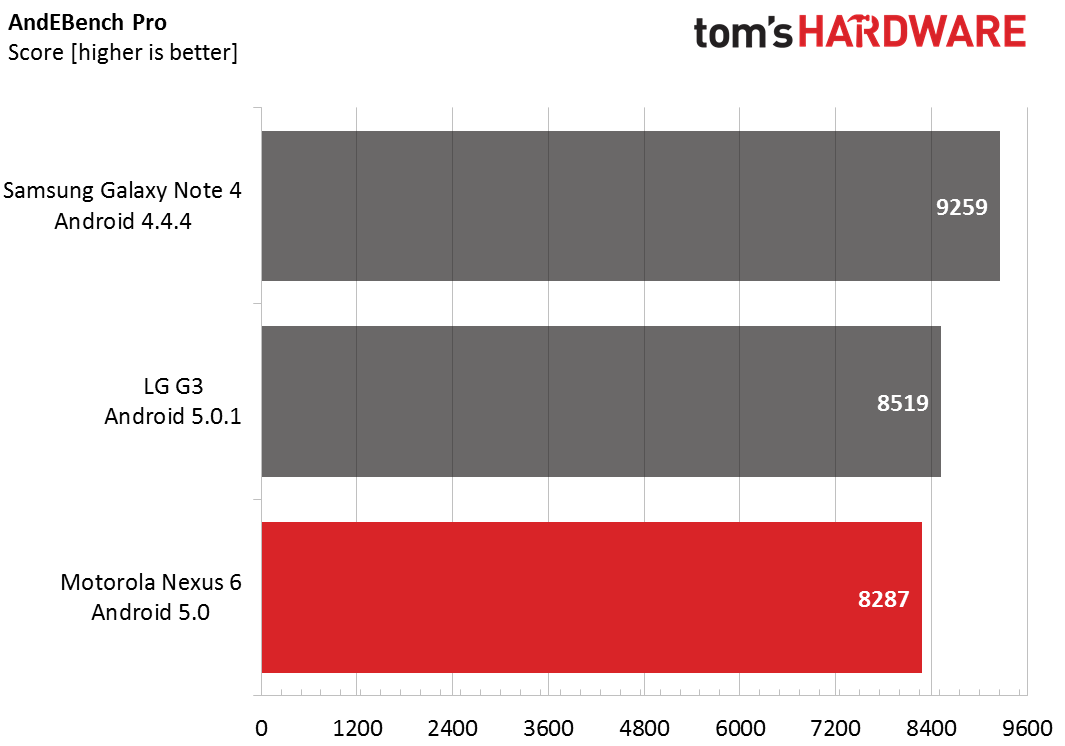
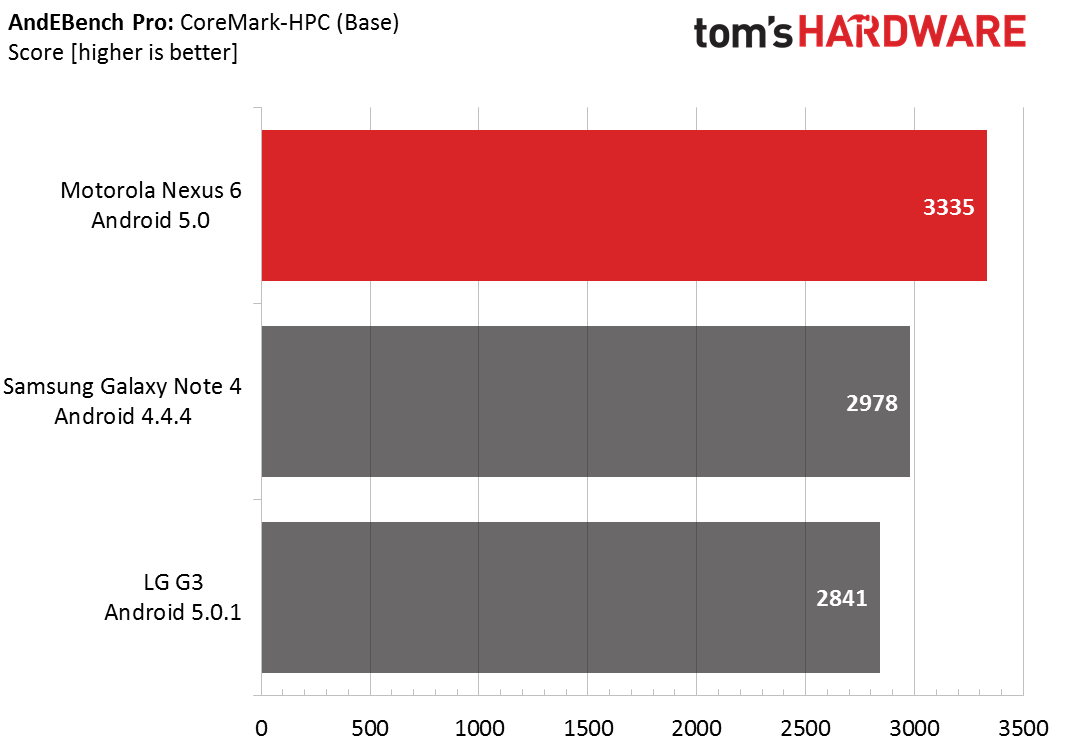
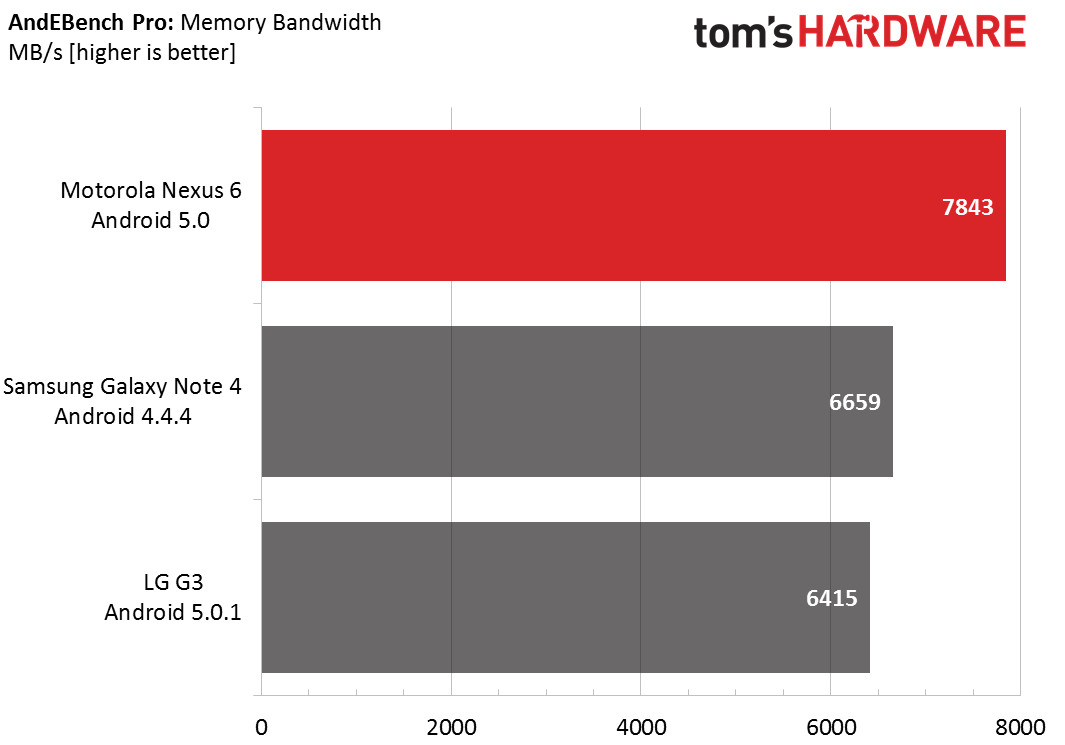
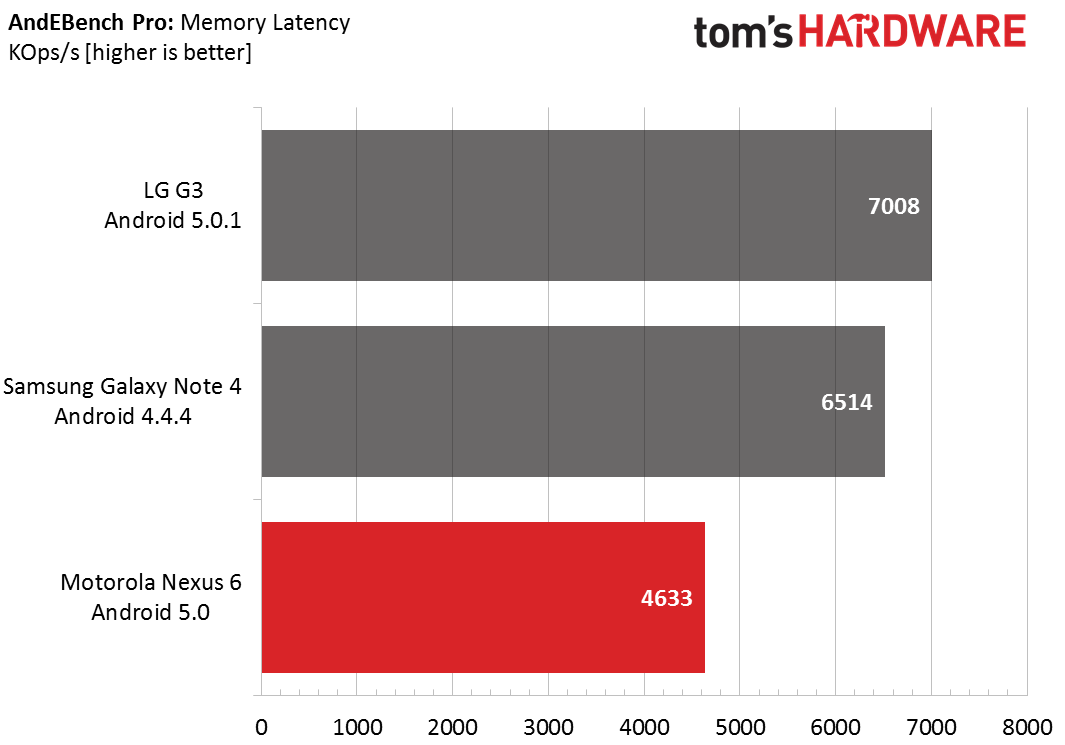
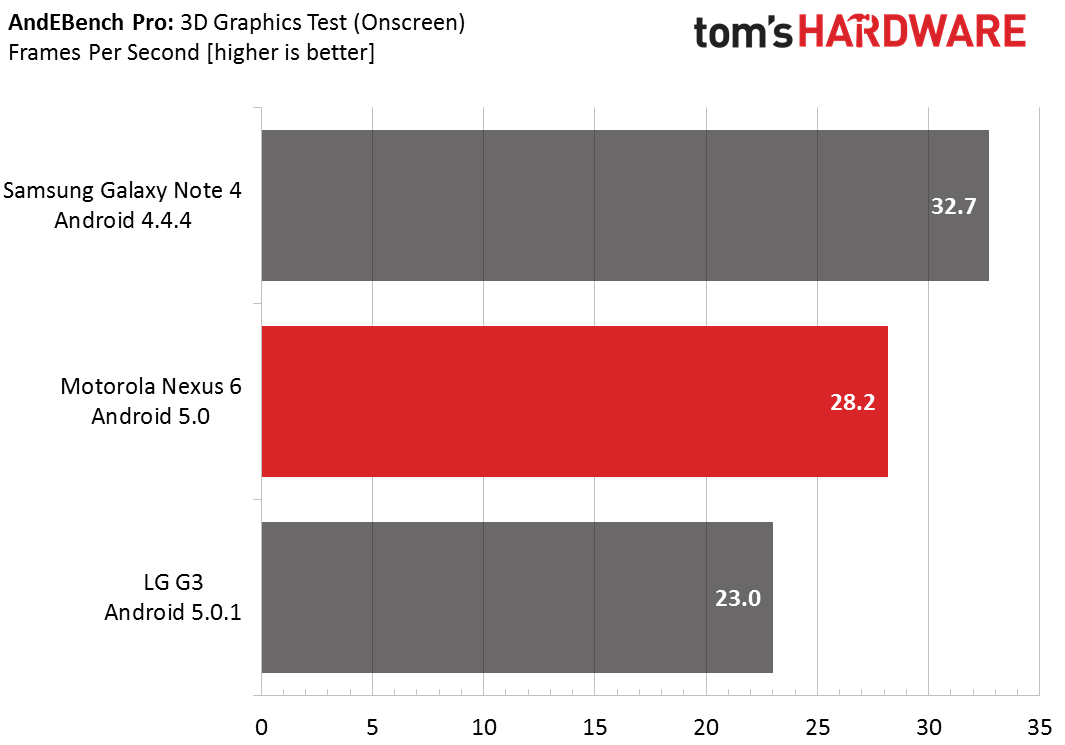
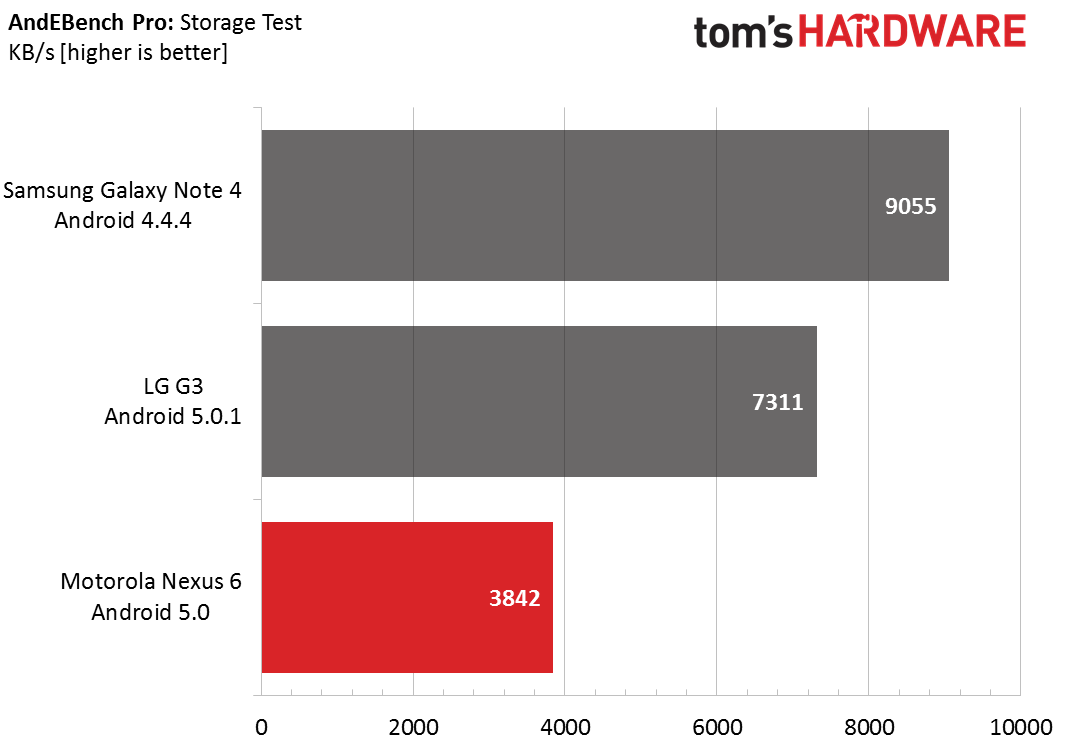
In the CPU-centric CoreMark-HPC test, we see the Nexus 6 pull ahead of the Note 4 again, albeit by a slimmer 12% margin. We also see the Note 4 post a higher 3D graphics score, with a similar 16% margin.
Internal storage performance is where the Nexus 6 really falters. Overall, it's 2.4x slower than the internal NAND in the Note 4. The table below shows the breakdown of the storage test.
AndEBench Pro Storage Test
| Header Cell - Column 0 | 512B SW | 512B RW | 4KB SR | 4KB SW | 4KB RR | 4KB RW | 256KB SR | 256KB RR |
|---|---|---|---|---|---|---|---|---|
| Galaxy Note 4 | 508 | 1010 | 20781 | 3072 | 20722 | 8078 | 97075 | 96908 |
| Nexus 6 (5.0) | 249 | 609 | 5905 | 1708 | 5968 | 6195 | 21194 | 26086 |
| Nexus 6 (5.1) | 163 | 702 | 8211 | 1041 | 6779 | 6587 | 30966 | 33187 |
*First letter: S=sequential, R=random
**Second letter: R=read, W=write
***Values in KB/s - Higher is better
Get Tom's Hardware's best news and in-depth reviews, straight to your inbox.
For the numbers in the table, the Note 4 was running Android 5.0.1 (update arrived after these charts were made), although the scores did not change significantly compared to KitKat. Write performance for the Nexus 6 running the original Android 5.0 build hovers around one-half that for the Note 4, while read performance takes an even larger 3.5-4.5x hit. After we completed all of our charts (of course), the Android 5.1 update for the Nexus 6 appeared, which is supposed to improve storage performance. Overall, we do see some modest gains for reads (now only 2.5-3.1x slower than the Note 4) and a couple of regressions for writes. The read values did fluctuate a bit more than usual, with the 256KB reads ranging from 18761-38985 KB/s. The relatively small differences in CPU and GPU speed shown above should not be noticeable in everyday use, but the Nexus 6's reduced storage performance definitely impacts app load times.
The cause for the low storage performance is Android's Full Disk Encryption (FDE), which has been an option since Honeycomb. This is no longer an option for the Nexus 6 however, since it's enabled by default. The snag is that the Nexus 6 performs the file encryption/decryption on the CPU rather than dedicated hardware, which hurts performance and battery life. At least your files remain secure if the device is lost or stolen.
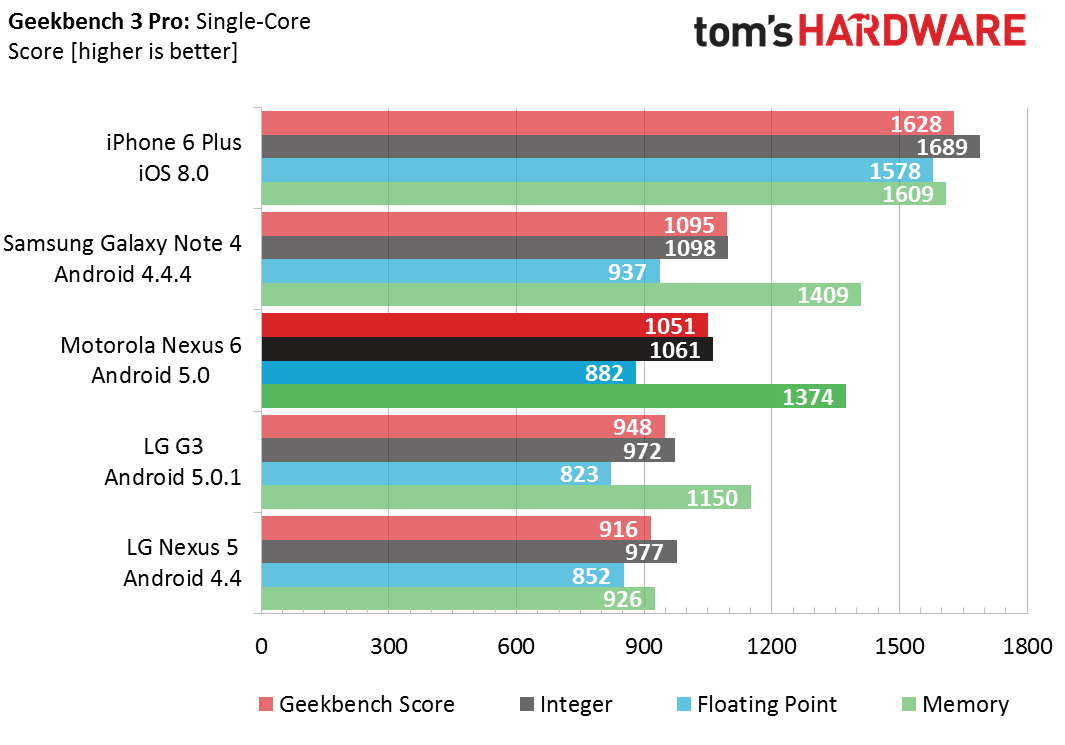
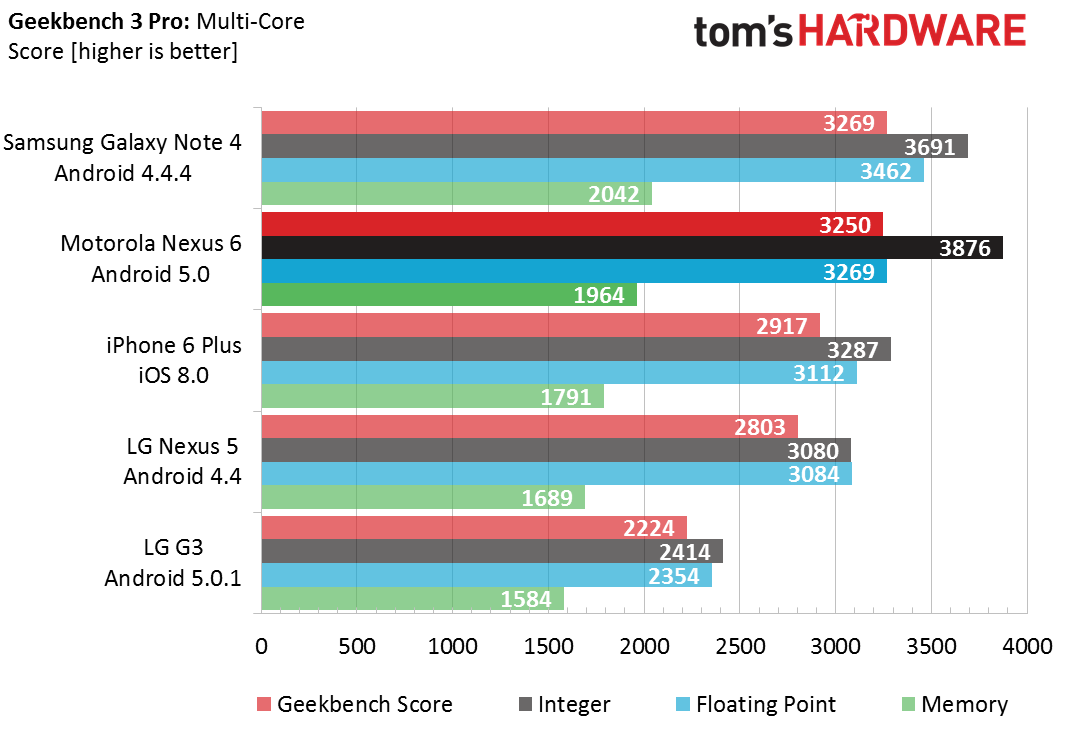
The Nexus 6's CPU performance advantage over the Note 4 disappears in Geekbench 3. Whatever small difference there is, its origin is elusive. There does not seem to be a clear pattern between benchmarks, whether they are single- or multi-core, integer or floating-point, or stress cache or memory bandwidth.
It's also interesting to see the older Snapdragon 800, running four Krait 400 CPU cores at 2.26GHz, perform nearly as well as the 2.65GHz Krait 450 cores. In the Single-Core test, the Snapdragon 805 is only 9% faster for integer operations and 4% faster for floating-point. Krait 450's 17% clock rate advantage doesn't translate into much higher performance.
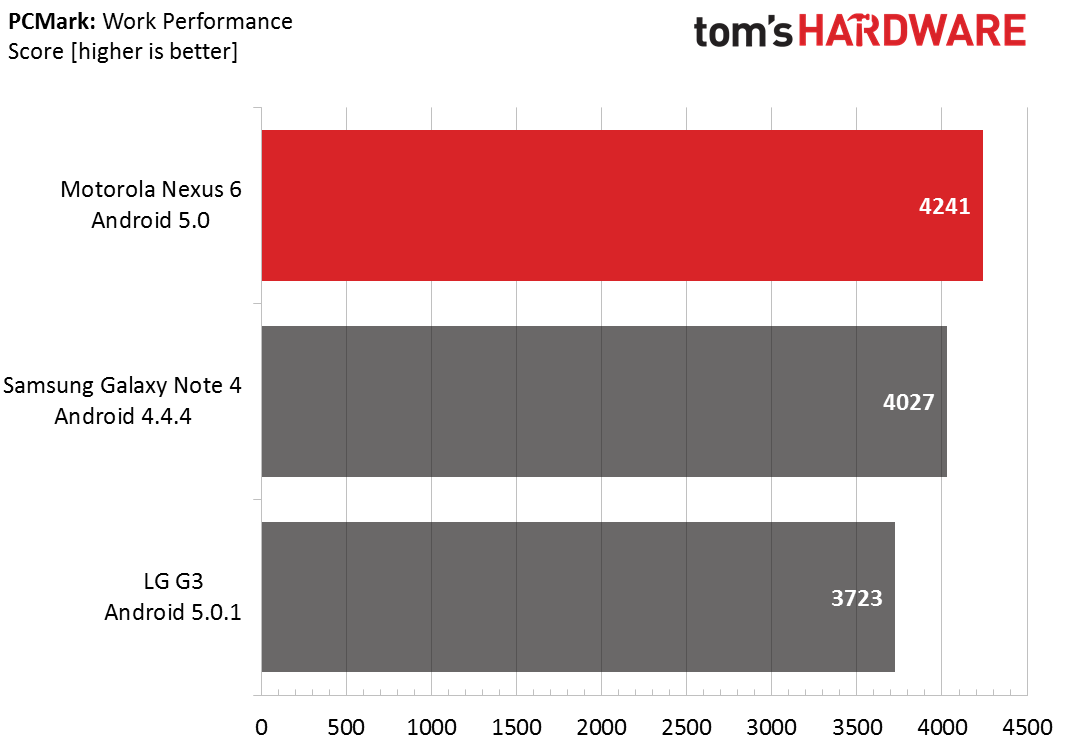
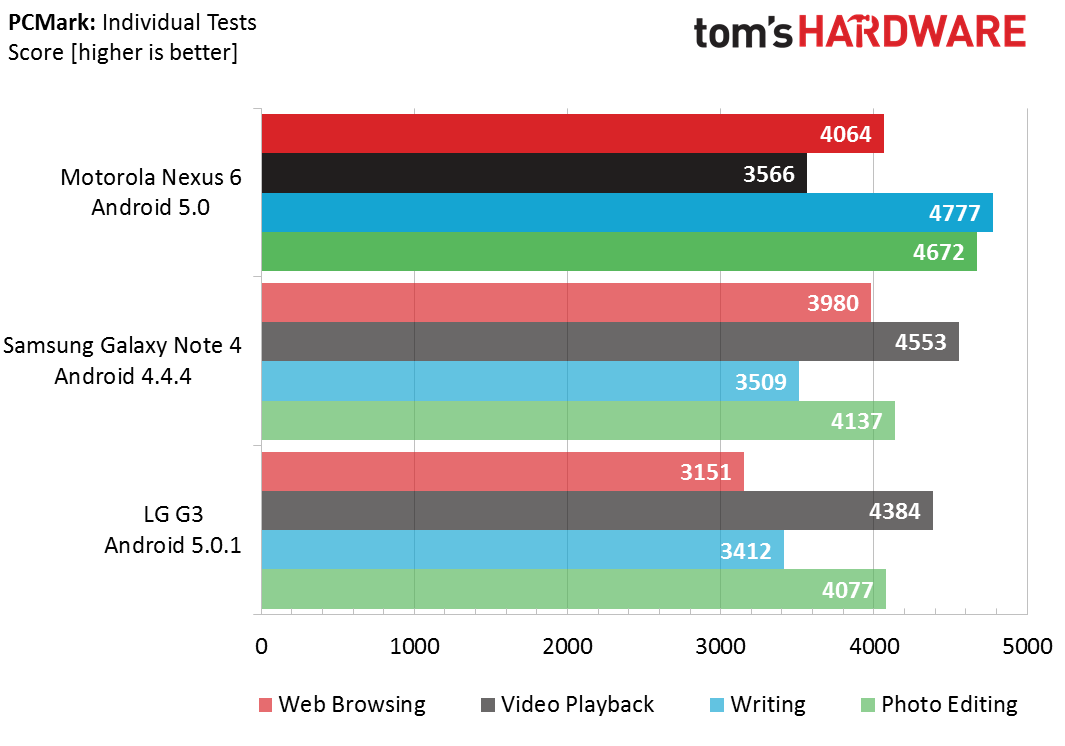
PCMark is a new addition to our benchmark suite, which is why we have limited data for comparison. Unlike our other tests, PCMark is based on real-world use cases rather than being purely synthetic or algorithmic.
Here we see little variation in terms of the total score; the Nexus 6 only scores 14% higher than the LG G3. Looking at the individual workloads shows more variation. The Nexus 6 performs well on the Writing test, but falls behind on the Video Playback test.
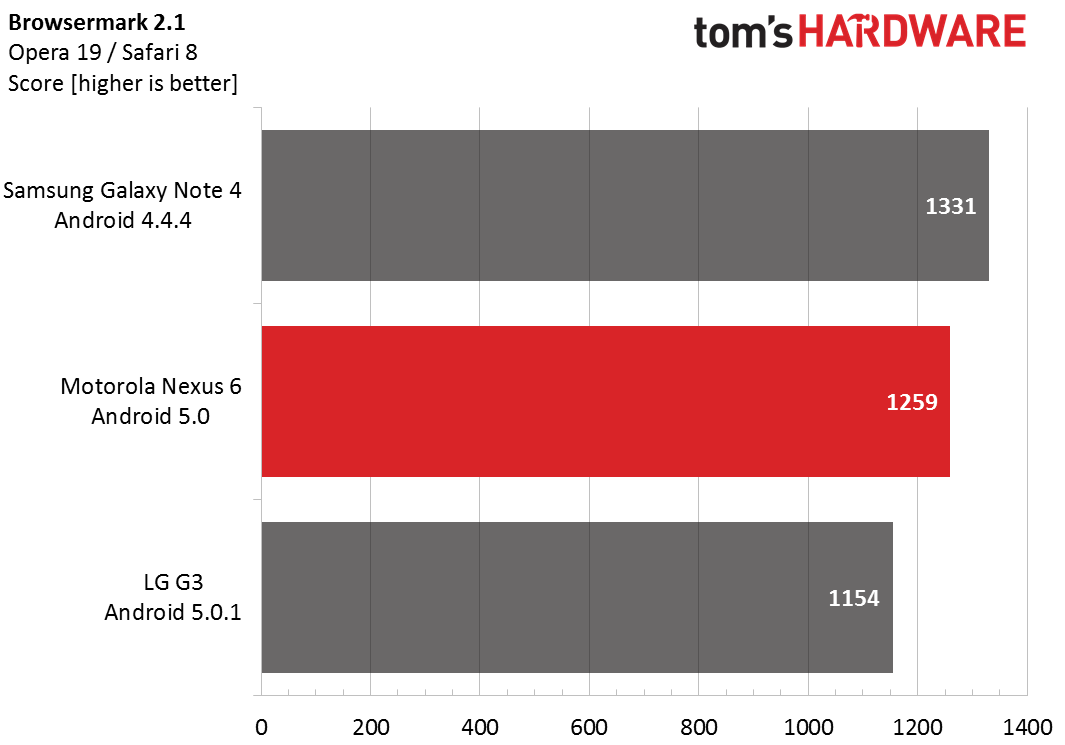
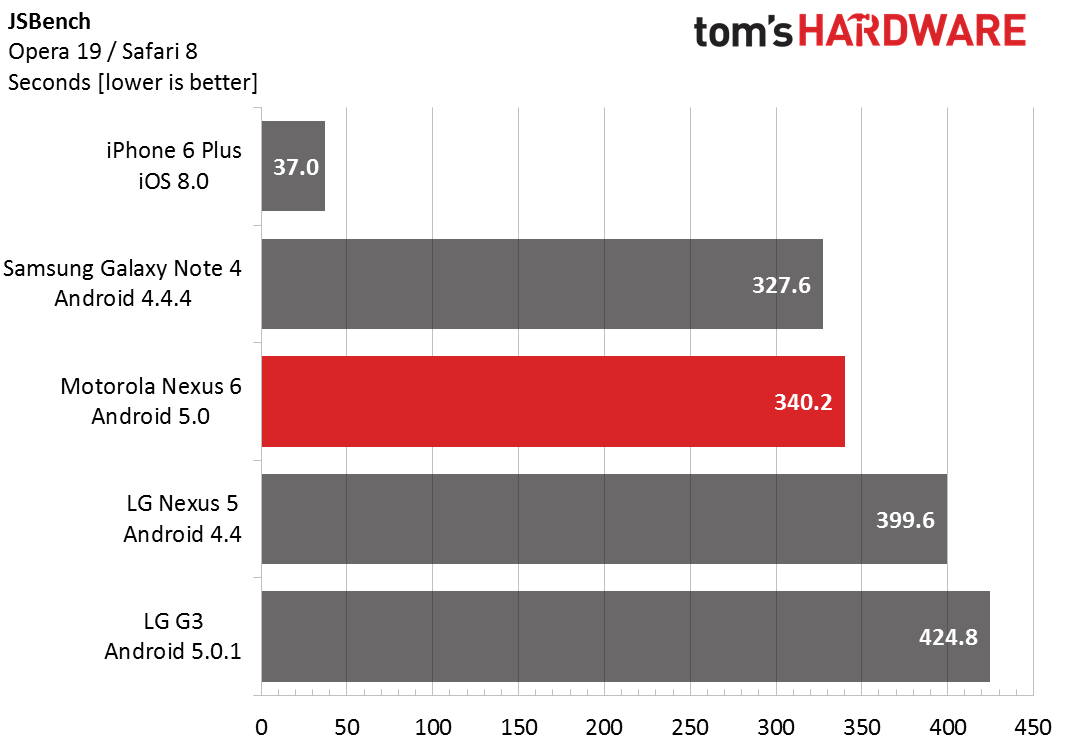
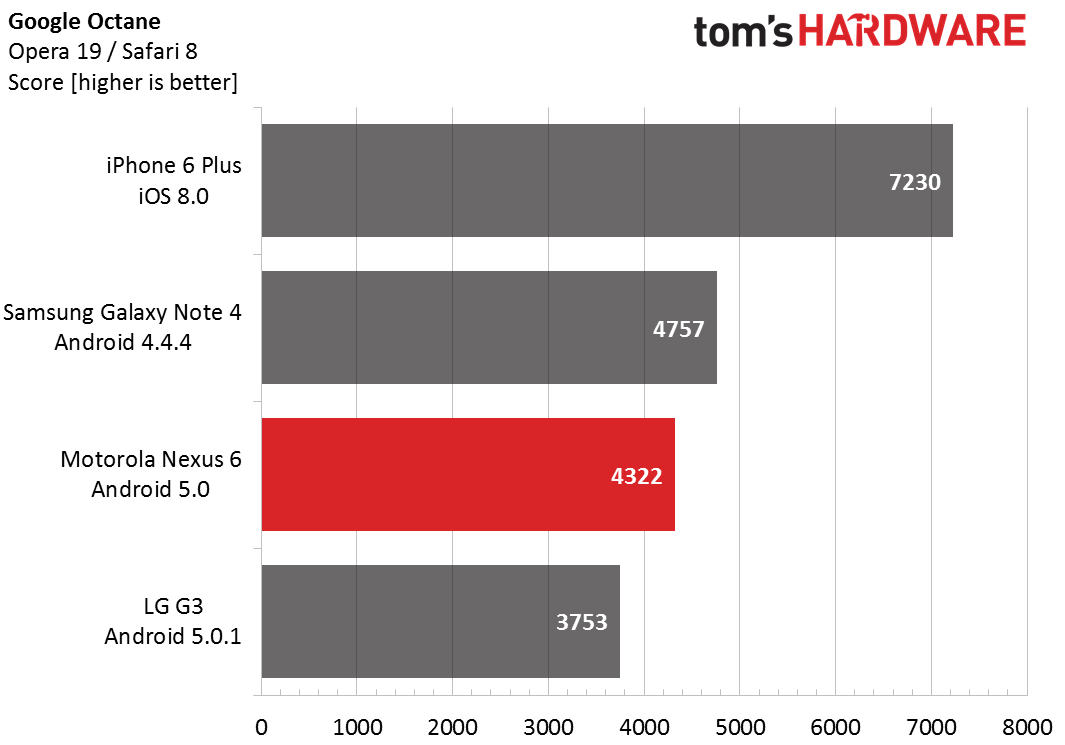
We see similar performance between the Nexus 6 and Note 4 across our browser-based tests. The Nexus 6 manages a meager 15% improvement over the Nexus 5, basically reflecting the clock rate difference between the two.
In terms of CPU and system performance, the Nexus 6 does not offer much more than the Nexus 5. Its small gains will be hard to notice in everyday use. What will be noticeable, is the lower internal storage performance due to FDE. Informal testing relative to the Note 4 showed apps launching anywhere from under a second to several seconds slower on the Nexus 6.
-
MobileEditor ReplyWhy wasn't the S6 used in this comparison?
Primarily because of the difference in screen size. If someone is considering a 6-inch phone, they probably are not interested in 5-inch phones. Thus, we compared it to other devices with a 5.5-inch or larger screen (and the Nexus 5 just because it was the previous generation).
- Matt H. -
Desertlax I think there is a typo about price, the nexus 6 is listed as 649 and 699 on the play store, not "starting at $750".Reply -
Tanquen I don’t know if Google lowered the price or when but it’s been $649 for the last week or so that I’ve been thinking of buying it. So I don’t get the repeated complaint that the price is $750 and too high. ???Reply -
MobileEditor ReplyI think there is a typo about price, the nexus 6 is listed as 649 and 699 on the play store, not "starting at $750".
Thanks for pointing this out. The article has been updated to reflect the current pricing.
- Matt H. -
Stryfex Did I hit my head and go back in time by like 6 months? Why is toms hardware posting reviews of the Nexus 6?Reply -
rtfizzel The Nexus 6 camera does have OIS. At least it is listed as a feature by Google and many other reviews.Reply
https://www.google.com/nexus/6/ -
rtfizzel My bad, misread. Apologies.ReplyThe Nexus 6 camera does have OIS. At least it is listed as a feature by Google and many other reviews.
https://www.google.com/nexus/6/ -
Chillyblue I have owned my N6 since it came out. Unlike others, I ordered it on release date, and got it five days later.Reply
By now long discussions about his big it is are redundant and moot. Those who purchase the phone known that, and like the screen real estate. Size is a preference they choose. If someone wants a smaller screen, they have unlimited options. To be honest, one become quite accustomed to the size rather quickly.Enough about size. Oh, it fits perfectly into my Levi Strauss jeans back pocket.
This phone since upgrading to 5.1 is a lightening fast. I run stock rooted with Franco Kernel. Antutu benchmark is 55,000 and Gerebench is 1200 single core, and 3600 multiple. I've run both encrypted and unencrypted... and frankly I csntvdetect any difference other than a faster boot time.
The build quality is excellent, the screen accurate and detailed, the camera gets the job donecwith clarity and definition....if you use a different third party camera app the results get better.
I've owned a HTC M8, and a Samsung note 3. Touch Wiz sucks, and bulild quality was toy like. HTC M8 offered excellent build quality and sense is far less intrusive then touch wiz.
Personally, pure Android, a bigger screen, faster updates, excellent build quality all make this phone a winner.
